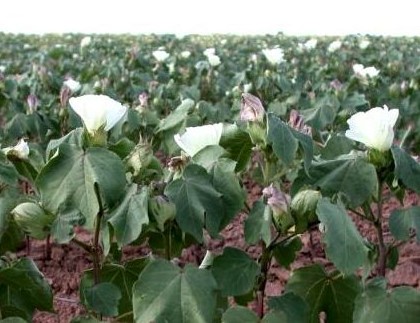
Agricultural News
2010 Oklahoma Cotton Crop Potential Remains Above Average
Tue, 24 Aug 2010 5:52:17 CDT
 The 2010 Cotton Crop in the Rolling Plains of North Texas, Oklahoma and Kansas was planted and started growing with an exceptional amount of moisture. Now, it is maturing in an extended dry spell in much of the area. How the crop is handling the different weather is explained by Shane Osborne, Oklahoma State University Extension assoc. specialist:
The 2010 Cotton Crop in the Rolling Plains of North Texas, Oklahoma and Kansas was planted and started growing with an exceptional amount of moisture. Now, it is maturing in an extended dry spell in much of the area. How the crop is handling the different weather is explained by Shane Osborne, Oklahoma State University Extension assoc. specialist:
"Hot, hot and more hot. If July's rain was equivalent to a feast, then August's heat and humidity would be the famine. Since mid-July temperatures reached and have basically stayed between 95 and 102 degrees. Let's be honest, we kind of expect that, but what about the humidity? The average daily humidity for July never dropped below 52 percent and for two-thirds of the month was above 70 percent. That is definitely above average for this part of the world. In typical August fashion, temperatures have stuck around the century mark most of the month.
"Any cotton that has had adequate moisture this period seems to have set a large amount of fruit in a short time. Even though our dryland acres have not flourished in August as compared to July, most of those acres still have a good fruit set with above average yield potential.
"The fields where cotton was planted behind a harvested wheat crop have taken the hardest hit from the recent hot, dry weather. Those acres will require significant rain in August to maintain decent yield potential. Typically, between Aug. 20-Sept. 1 is when we reach our "physiological cutout" in Oklahoma. This cutout term refers to the physical condition when the plant reaches the stage when it only has four nodes of growth (branches) above its highest first position white flower. At this time, a well-loaded plant will stop production of additional fruiting branches and focus on supplying the physiological needs of the bolls already on the plant.
"This time of year is also referred to as our last "effective bloom date." Basically, this means any blooms produced after this time will typically not have enough time to mature into an open boll. Therefore, blooms on Aug. 25 should mature by Oct. 15-25. This is also the time when irrigated producers should be considering their last irrigation date.
"Traditionally, on furrow irrigated cotton, we want to have good moisture in the soil profile Sept. 1. If this exists, no additional irrigation is necessary. However, under sprinkler or drip irrigation, we may want to consider extending irrigation into the first seven to 10 days of September. Typically, with furrow irrigation we tend to irrigate less frequently but with higher volumes of water. With sprinkler or drip irrigation, we irrigate more frequently with less volume. Often the lower volumes of water applied through these systems require us to extend our irrigation run compared to furrow irrigation.
"Physiologically, furrow irrigation should stop at the first naturally opened boll (not opened from stress) and sprinkler or drip irrigation may need to continue an additional seven to 10 days after the first boll.
"With the prospects of terminating irrigation on the horizon, another crop comes to mind. You won't hear me talking about wheat as much (I'm strictly a cotton guy), but with the substantial number of cotton acres planted this year behind harvested wheat and the potential for next year (due to the positive market outlook for cotton), it would be good to mention a few things with regard to the prospective acres in 2011.
"Growers interested in planting cotton behind their harvested wheat next year have some important considerations this year when their wheat crop is being established. The primary concern is with the grower's choice of herbicide. Many of the popular wheat herbicides may potentially be a problem for next year's cotton crop.
"For example, sulfonylurea herbicides (often referred to as SU herbicides) which include Ally, Finesse or Glean (or some combination of these products) definitely have the potential for carryover when considering cotton next summer. In addition to normal or expected carryover problems, sometimes these problems can be intensified in certain situations. This specific class of herbicide (SU) is known to remain in the soil for longer periods of time as the pH of the soil increases. Unfortunately, these are not the only wheat herbicides with carryover concerns when considering a cotton crop down the road. Sounds like a lot to keep up with? Not really. Just remember the three most important things when it comes to herbicide choice. READ THE LABEL. READ THE LABEL. READ THE LABEL.
"All of this important information can be found on any herbicide label. Usually carryover concerns are addressed in the "Crop Rotation" section or it may sometimes be referred to as a "plant back interval." Either way it is usually easy to find when reading. Often times there are alternative herbicides that provide adequate weed control which may allow the flexibililty of following your wheat crop with cotton. If you want to keep your options open and remain flexible, do your homework or get someone else to do it for you. In many instances, your local Extension county educator may be aware of these consequences. If you need help with your wheat herbicide options and how they may affect cotton or want to discuss anything else I have mentioned, call me and I will be glad to help."
Click here for more information from NTOK regarding cotton production in Oklahoma, Kansas and North Texas.
WebReadyTM Powered by WireReady® NSI
Top Agricultural News
More Headlines...




















